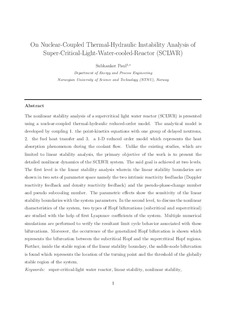| dc.contributor.author | Singh, Munendra Pal | |
| dc.contributor.author | Subhanker, Paul | |
| dc.contributor.author | Singh, Suneet | |
| dc.date.accessioned | 2019-10-15T06:44:40Z | |
| dc.date.available | 2019-10-15T06:44:40Z | |
| dc.date.created | 2019-05-15T14:44:59Z | |
| dc.date.issued | 2019 | |
| dc.identifier.citation | International journal of thermal sciences. 2019, 137 650-664. | nb_NO |
| dc.identifier.issn | 1290-0729 | |
| dc.identifier.uri | http://hdl.handle.net/11250/2622109 | |
| dc.description.abstract | A Novel Nodalized Reduced Order Model (NNROM) is developed in this paper to analyze the linear stability phenomena in a heated channel with supercritical water as a coolant. The existing models are based on finite volume approach, leading to a large number of non-linear time-dependent ODEs, making linear stability analysis (for infinitesimally perturbation) computationally expensive and tedious. Moreover, the non-linear stability analysis considers the effect of small but finite perturbations which becomes even more difficult. It is pointed out that the accuracy of the reduced order model developed here is not compromised, as the comparisons of the model results, with existing studies show good agreement. In ordered to develop the NNROM, the heated channel is divided into N number of nodes. The one-dimensional mass, energy and momentum conservation partial differential equations are converted into the corresponding time-dependent non-linear ordinary differential equations (ODEs) by applying the weighted residual method. The linear stability threshold of the system is determined by analyzing the eigenvalues of the Jacobian matrix at the steady states of the set of ODEs. Moreover, the linear stability boundary (Hopf bifurcation line) is represented in terms of trans-pseudo-critical phase change number, and pseudo-subcooling number. A parametric study is done to identify the change in linear stability behavior of the system with the design parameters. Furthermore, non-linear stability analysis is carried out to identify Generalized Hopf (GH) bifurcation points in the space. The GH points divide the stability boundary into sub-critical Hopf and super-critical Hopf parts, which is further varify by the numerical simulations. The identification of sub-critical region is quite important as it shows unstable limit cycles in the (linearly) stable region. | nb_NO |
| dc.language.iso | eng | nb_NO |
| dc.publisher | Elsevier | nb_NO |
| dc.rights | Attribution-NonCommercial-NoDerivatives 4.0 Internasjonal | * |
| dc.rights.uri | http://creativecommons.org/licenses/by-nc-nd/4.0/deed.no | * |
| dc.title | Development of a novel nodalized reduced order model for stability analysis of supercritical fluid in a heated channel | nb_NO |
| dc.type | Journal article | nb_NO |
| dc.type | Peer reviewed | nb_NO |
| dc.description.version | acceptedVersion | nb_NO |
| dc.source.pagenumber | 650-664 | nb_NO |
| dc.source.volume | 137 | nb_NO |
| dc.source.journal | International journal of thermal sciences | nb_NO |
| dc.identifier.doi | 10.1016/j.ijthermalsci.2018.12.005 | |
| dc.identifier.cristin | 1698109 | |
| dc.description.localcode | © 2018. This is the authors’ accepted and refereed manuscript to the article. Locked until 29.12.2020 due to copyright restrictions. This manuscript version is made available under the CC-BY-NC-ND 4.0 license http://creativecommons.org/licenses/by-nc-nd/4.0/ | nb_NO |
| cristin.unitcode | 194,64,25,0 | |
| cristin.unitname | Institutt for energi- og prosessteknikk | |
| cristin.ispublished | true | |
| cristin.fulltext | postprint | |
| cristin.qualitycode | 1 | |

